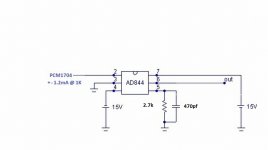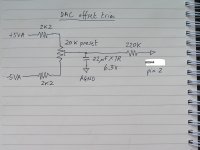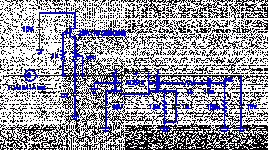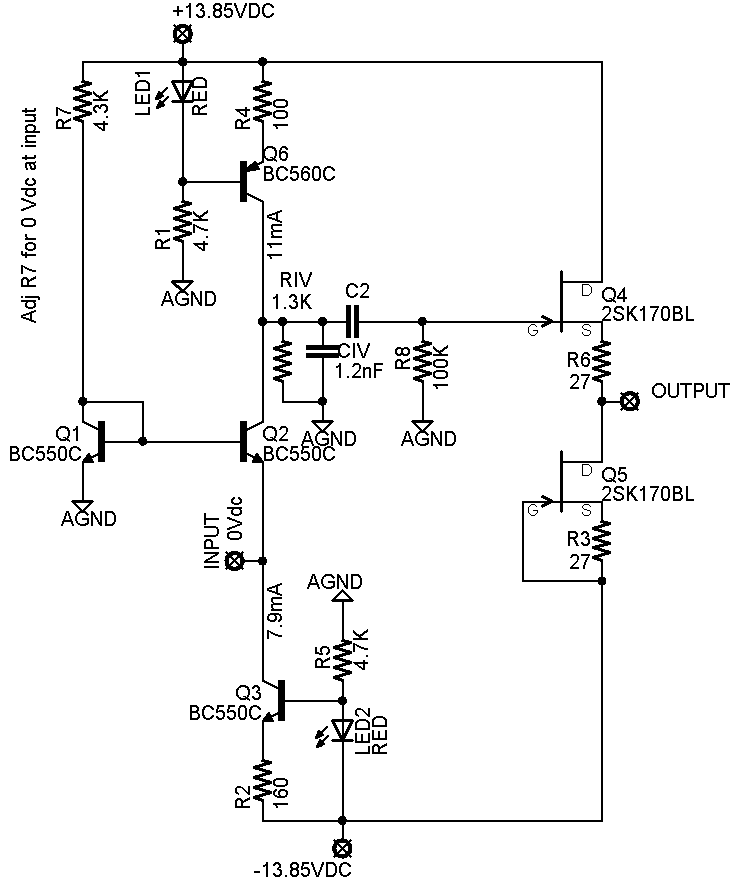> the 844 as-is is much better than almost all discrete circuitry
Except when you want to use it as a BJT CEN and wants lower input impedance than 65 ohm ?
🙂
(PS I like the 844 as well, especially as in LC's phono.)
Patrick
Except when you want to use it as a BJT CEN and wants lower input impedance than 65 ohm ?
🙂
(PS I like the 844 as well, especially as in LC's phono.)
Patrick
Here is what works great for my PCM1704, if your doing a sub for another I/V opamp, don't forget to disconnect the feedback loop around the old opamp.
And give thanks to Pedja Rogic for letting this out of the bag, as I think it would be hard pressed for even a discrete I/V to better the sound this can give. And kudos Barrie Gilbert for designing the AD844 and abraxilito for the dac dc offset nulling circuit
Cheers George
And give thanks to Pedja Rogic for letting this out of the bag, as I think it would be hard pressed for even a discrete I/V to better the sound this can give. And kudos Barrie Gilbert for designing the AD844 and abraxilito for the dac dc offset nulling circuit
Cheers George
Attachments
Last edited:
And for TDA5141. Again don't forget to remove all feedback from the old opamp, and you probably could use the simpler dac offset nuller that abraxilito did for the PCM1704..
Cheers George
Cheers George
Attachments
Last edited:
If I understood correctly instead the 15v psu + 2sk170 (2sk369) + VR1 + C1 can't be used, I must use the 2nd pic with the +-5V, right? with 20K preset I have to ajust 0VDC at pin 2 of AD844, right?
I leave that for others to answer as I have only used the simpler abraxilito method.
Cheers George
Cheers George
> the 844 as-is is much better than almost all discrete circuitry
Except when you want to use it as a BJT CEN and wants lower input impedance than 65 ohm ?
🙂
(PS I like the 844 as well, especially as in LC's phono.)
Patrick
Some people are better with discrete than others 😉
jan
I suggest you read his reports a bit closer - he only got the issues when the reg was powering something digital from my reading of it. If it had been stability he could have fixed that up, he knows enough about Bode plots I reckon - in a reg its the stability of the whole loop, not just the opamp.
Walt and I also had issues with 797 stability in our 1994 regulator series. I tried to convince Walt to use another opamp which he eventually agreed to.
The 'touchiness' of the 797 was related to the internal neutralisation, which is a form of positive feedback which can, depending on the feedback loop characteristics, cause instability. That doesn't mean its not a good chip - its a very good device, but you must know what you are doing.
BTW I just read earlier posts about people biasing the Tz node of the AD844 up to 10mA to force it into class A. Please be aware that at those currents, the Tz node is quite nonlinear, causes gross distortion and may also exhibit slew rate limiting. Don't get hung up on class A too much - the 844 as-is is much better than almost all discrete circuitry.
jan
😀 ironic much?
yes it was that series of articles I remembered it from, related to the superregulators.
in no way am I criticising Walt, or Scott's work, clearly they both know what they are doing..... I have had excellent results with the AD797, even at unity gain in Flea type regs, its one of my favorite opamps, perhaps THE favorite opamp.
It does require a bit of babying at low gain though in my experience and I believe its unity gain stability stamp should come with a disclaimer, because it is used in ways it is not really suitable for, by opamp rollers and designers alike because of this.
Jan, you mean pin 8?, yes the layout and component choice regarding this pin's use are critical, as well as being quite important to squeezing the most out of it. either use it properly or not at all IMO
I suggest you read his reports a bit closer - he only got the issues when the reg was powering something digital from my reading of it. If it had been stability he could have fixed that up, he knows enough about Bode plots I reckon - in a reg its the stability of the whole loop, not just the opamp.
Walt and I also had issues with 797 stability in our 1994 regulator series
that, is ironic.
perhaps your taste for it is not as refined as you think?
of course it was stability of the whole loop, isnt it always? but it was stability of the AD797 in that whole loop, so it was discarded and not recommended, replaced by AD825 if I remember correctly.
he could most likely have worked with it and fixed it in situ, but he was writing an article for others to implement and clearly there were a few issues that made it hard to recommend under this use case.
Last edited:
You're missing important detail there because of not taking my advice to read his reports closer. I'll leave you to figure out what you're missing 😀 Hint - the date I was talking about wasn't 1994.
dont have time now, havent read them for years. i'll look into that when I refresh on his articles soon, looking to do a layout of the recent shunt version.
but another point I will make is that Walt is not the only one to have had trouble with AD797 at low or unity gain. its one of the reasons its been labelled as a somewhat cranky opamp. maybe its simply that running at low or unity gain accentuates issues with problem PCB layouts that would otherwise be fixed with higher gain.
but another point I will make is that Walt is not the only one to have had trouble with AD797 at low or unity gain. its one of the reasons its been labelled as a somewhat cranky opamp. maybe its simply that running at low or unity gain accentuates issues with problem PCB layouts that would otherwise be fixed with higher gain.
Yes Walt had stability issues, that's what Jan was talking about, but he didn't abandon the AD797 in that design until he came up against RF issues. Only then did he chuck out the part in favour of AD825.
Yes Walt had stability issues, that's what Jan was talking about, but he didn't abandon the AD797 in that design until he came up against RF issues. Only then did he chuck out the part in favour of AD825.
huh? now your just being silly, just because there was another issue in addition to the stability that was the final straw, doesnt mean that stability was not an issue, or even the major issue. I'm not saying it was or wasnt, its been too long for me to remember, but why seemingly argue that stability was not an issue?
anyway thanks for the reminder, its always good re-reading articles from these guys as experience grows, further things usually click into place.
Stability wasn't the issue that killed the AD797 in that design - Walt was happy that it was resolved enough to continue to keep the AD797 in that reg design. You think Mr Jung would run with a design that he didn't consider good enough to publish and recommend others to copy when they needed a reg? To me that says stability wasn't a significant issue in that design.
Looks like George is happy with Zin = 65 ohm for his 1704 after all.
But I have the SEN, and the AD844.
🙂
http://www.diyaudio.com/forums/digi...-minimalistic-iv-converter-5.html#post2718757
Patrick
But I have the SEN, and the AD844.
🙂
http://www.diyaudio.com/forums/digi...-minimalistic-iv-converter-5.html#post2718757
Patrick
Last edited:
Too high for me even for the 1704.
But I know some people has tried the 1704 with 22R passive IV followed by tube stage.
So maybe 3x 844 in parallel will do ....
I still prefer my SEN, by far. But then I am biased.
Patrick
But I know some people has tried the 1704 with 22R passive IV followed by tube stage.
So maybe 3x 844 in parallel will do ....
I still prefer my SEN, by far. But then I am biased.
Patrick
Input Z for the AD844 is 50ohm typical, , and happy with it is an understatment, it's a game changer as far as being compared to the normal highend opamps with feedback.
This AD844 when used without global feedback and even with it's own output buffer has made me feel that all other opamp based I/V's are seriously flawed, and I don't think I have it at it's best yet either.
Someone said it needs to be biased higher than it's quiescent current of 6.5mA, but correct me if I'm wrong but the PCM1704 can only give +-1.2mA at full swing 0dbf.
But maybe they meant with the TDA1541 which gives out a much higher than that.
Cheers George
This AD844 when used without global feedback and even with it's own output buffer has made me feel that all other opamp based I/V's are seriously flawed, and I don't think I have it at it's best yet either.
Someone said it needs to be biased higher than it's quiescent current of 6.5mA, but correct me if I'm wrong but the PCM1704 can only give +-1.2mA at full swing 0dbf.
But maybe they meant with the TDA1541 which gives out a much higher than that.
Cheers George
We have eventually built the AD844 discrete using BC550 / BC560 (see the link above) ourselves to get to the low Zin of <10R.
I still prefer the SEN in an A-B test.
Patrick
I still prefer the SEN in an A-B test.
Patrick
- Home
- Source & Line
- Digital Line Level
- Using the AD844 as an I/V



